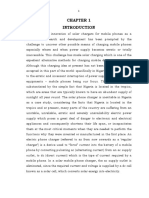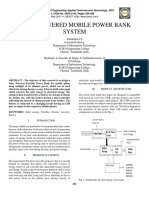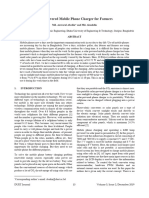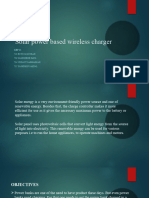0 ratings0% found this document useful (0 votes)
Fin Irjmets1658312813
Fin Irjmets1658312813
Uploaded by
goswillchiCopyright:
© All Rights Reserved
Available Formats
Download as PDF, TXT or read online from Scribd
Download as pdf or txt
Fin Irjmets1658312813
Fin Irjmets1658312813
Uploaded by
goswillchi0 ratings0% found this document useful (0 votes)
Original Title
fin_irjmets1658312813
Copyright
© © All Rights Reserved
Available Formats
PDF, TXT or read online from Scribd
Share this document
Did you find this document useful?
Is this content inappropriate?
Copyright:
© All Rights Reserved
Available Formats
Download as PDF, TXT or read online from Scribd
Download as pdf or txt
0 ratings0% found this document useful (0 votes)
Fin Irjmets1658312813
Fin Irjmets1658312813
Uploaded by
goswillchiCopyright:
© All Rights Reserved
Available Formats
Download as PDF, TXT or read online from Scribd
Download as pdf or txt
You are on page 1/ 5
e-ISSN: 2582-5208
International Research Journal of Modernization in Engineering Technology and Science
( Peer-Reviewed, Open Access, Fully Refereed International Journal )
Volume:04/Issue:07/July-2022 Impact Factor- 6.752 www.irjmets.com
SOLAR MOBILE CHARGE
Prof. Veena S*1, Vijay DG*2
*1Professor, Department Of Electronics And Communication, S J C Institute Of Technology,
Chickballapur, Karnataka, India.
*2Student, Department Of Electronics And Communication, S J C Institute Of Technology,
Chickballapur, Karnataka, India.
ABSTRACT
In this report we are presenting a designing of a solar mobile chargers. The development of solar charge takes
place from a fundamental level such as soldering lamination and panel making. The developed charger is
planned for 6 volts with MA capacity in bright sunlight and down to 5 volts using the regulator. It is not possible
to charge mobile batteries everywhere at any time, so we design this mobile charger so that we can charge
mobile batteries everywhere at anytime anywhere. In this paper we are using the concept of energy harvesting
using solar energy for battery charging purpose. With its use, we can charge our mobile batteries in remote
areas where there is a problem of electricity. The cost of this circuitry can be reduced to certain extent so that
the common man can easily buy it and benefit from it.
Keywords: Solar Charge, Sunlight, Electricity.
I. INTRODUCTION
Solar cell phone chargers use solar panels to charge cell phone batteries. They can be used when no electricity
supply is available—either mains or, for example, a vehicle battery and are sometimes suggested as a way to
charge phones without consuming mains electricity, unlike electrical cell phone chargers. Some can also be
used as a conventional charger by plugging into an electrical outlet. Some chargers have an internal
rechargeable battery which is charged in sunlight and then used to charge a phone; others charge the phone
directly. There are also public solar chargers for mobile phones which can be installed permanently in public
places such as streets, park and squares. One such is the Strawberry Tree public solar charger. One cell phone
model was reported in 2010 to have a builtin solar charger. Solar chargers are commercially available for
cellphones. Solar cell phone chargers come in different shapes and configurations including folding Goal Zero,
Endless Sun Solar and types that unfold like petals Solio. They also come in the form of straps, with solar cells
on the outer surface and a rechargeable battery inside. Solar cell technology limits the effectiveness and
practicality of phone solar chargers for everyday use. Phone charge times vary depending on the solar panel
size and efficiency, or the battery capacity of models with batteries, further extending the charge times of solar
chargers. The fold-out design provides a larger solar panel, hence higher charge current, and is compact when
not in use. Solar chargers can be used to charge other rechargeable devices with requirements similar to a
mobile phone, such as Bluetooth headsets and music players. Solar chargers used to charge a phone directly,
rather than by using an internal battery, can damage a phone if the output is not well-controlled, for example by
supplying excessive voltage in bright sunlight. In less bright light, although there is electrical output it may be
too low to support charging, it will not just charge slower. Some of these chargers are flexible and some can also
power solar coolers.
Solar energy is the energy produced directly by the sun and collected elsewhere, normally the Earth. The sun
creates its energy through a thermonuclear process. The process creates heat and electromagnetic radiation.
Only a very small fraction of the total radiation produced reaches the Earth. The radiation that does reaches the
Earth is the indirect source of nearly every type of energy used today. The radiation that does reach the Earth is
the indirect source of nearly every type of energy used today. The exceptions are geothermal energy, and
nuclear fission and fusion. Even fossil fuels owe their origins to the sun; they were once living plants and
animals whose life was dependent upon the sun. Much of the world's required energy can be supplied directly
by solar power. More still can be provided indirectly. The practicality of doing so will be examined, as well as
the benefits and drawbacks. In addition, the uses solar energy is currently applied to will be noted. Due to the
nature of solar energy, two components are required to have a functional solar energy generator. These two
components are a collector and a storage unit. The collector simply collects the radiation that falls on it and
www.irjmets.com @International Research Journal of Modernization in Engineering, Technology and Science
[2559]
e-ISSN: 2582-5208
International Research Journal of Modernization in Engineering Technology and Science
( Peer-Reviewed, Open Access, Fully Refereed International Journal )
Volume:04/Issue:07/July-2022 Impact Factor- 6.752 www.irjmets.com
converts a fraction of it to other forms of energy (either electricity and heat or heat alone). The storage unit is
required because of the non-constant nature of solar energy; at certain times only a very small amount of
radiation will be received. At night or during heavy cloud cover, for example, the amount of energy produced by
the collector will be quite small. The storage unit can hold the excess energy produced during the periods of
maximum productivity, and release it when the productivity drops. In practice, a backup power supply is
usually added, too, for the situations when the amount of energy required is greater than both what is being
produced and what is stored in the container.
II. METHODOLOGY
Figure 1. Flowchart of solar mobile charge
III. TECHNOLOGY
Materials and Software used- Solar panel, LM358 Operational amplifier, 1N4007 diode, Light emitting diodes,
Universal serial bus connector, Zener diode, 7805 voltage regulator, Resistors, lithium ion batteries and Proteus
software for simulation.
Solar Module- The solar module consists of two 5.5V operating voltage solar panels connected in series to give
11V operating voltage. A current value of 160mA is obtained and used to charge the back-up Li-ion batteries.
For current to flow from source to sink, the source voltage must be higher than the sink voltage. Therefore, 11V
at source pushes 160mA current to charge battery rated 8V. D1 is a Red LED that indicates that solar panel is
receiving and converting solar energy into electrical energy and charging the back-up. R1 is a small-valued
330Ω fixed resistor that limits current flow to the LED D1. D2 is a blocking diode (1N4007) that ensures current
does not flow in the reverse direction to the solar panel in order to avoid damage to the panel. So, D2 ensures
flow of current only to the back-up and otherwise is not permitted.
Back-Up Module- The back-up module consists of two 3.7V Lithium-ion batteries connected in series to givea
total voltage of 7.4V and 8V when fully charged. As one 3.7V Li-ion battery gets to 4.2V when fully charged. The
blocking diode, D2 ensures current delivery to the back-up. The switch on the right hand side is used to deliver
power or not to deliver power to the regulator circuit.
Voltage Regulation Unit- The voltage regulation unit consists basically of U1 (LM7805 voltage regulator) that
regulates the voltage from the back-up and gives an output of 5V as shown in fig 3.18. C1 is a 10uF capacitor
that filters the output from the back-up before feeding the regulator, R5 is a 1kΩ resistor which limits the
current into D5 (a blue LED) used to indicate when load is charging. When mobile phone is charging, D5 is ON.
C2 is a 47uF polarised capacitor that further filters the output from the regulator before feeding the load.
www.irjmets.com @International Research Journal of Modernization in Engineering, Technology and Science
[2560]
e-ISSN: 2582-5208
International Research Journal of Modernization in Engineering Technology and Science
( Peer-Reviewed, Open Access, Fully Refereed International Journal )
Volume:04/Issue:07/July-2022 Impact Factor- 6.752 www.irjmets.com
Rectification Unit-This unit consists of a blockingdiode 1N4007, D6. D6 is used to ensure current flows in only
the direction of back-up to load and not otherwise. This is to ensure the mobile phone’s battery does not
discharge when back-up battery is LOW. The USB female connector, USBCONN delivers power to the phone for
charging.
Comparator Unit-With respect to the op-amp (LM358) circuit , If VIN > VREF then VOUT = +VCC while when VIN <
VREF then VOUT = -VCC. VREF is the voltage of the negative, pin 2 (INVERTING PIN), VIN is the input voltage at the
positive, pin 3 (NON-INVERTING PIN) andpin1 is the OUTPUT of the op-amp. The reference voltage is 8V i.e the
battery voltage. As the non-inverting (positive) input of the comparator is less than the inverting (negative),
output becomes LOW and this implies that the Green LED D4 will be OFF due to negative saturation of the
output. As input voltage increases such that VIN goes above reference voltage VREF (at the inverting pin), the
output voltage abruptly changes to HIGH in the direction of the positive supply voltage which is +VCC and this
causes the Green LED D4 to be ON due to positive saturation of the operational amplifier’s output [22]. These
ensure that the Green LED glows when the battery voltage is at 7.99V or 8V (i.e when fully charged) and LED
does not glow at less than 7.99V battery voltage. The zener diode D3 (1N4731A) ensures cut-off when
saturation is reached as battery voltage tries to go above 8V.
IV. WORKING ANALYSIS
They work on the principle of the photovoltaic effect. When certain materials are exposed to light, they absorb
photons and release free electrons. This phenomenon is called as the photoelectric effect. Photovoltaic effect is
a method of producing direct current electricity based on the principle of the photoelectric effect.
Based on the principle of photovoltaic effect, solar cells or photovoltaic cells are made. They convert sunlight
into direct current electricity. But, a single photovoltaic cell does not produce enough amount of electricity.
Therefore, a number of photovoltaic cells are mounted on a supporting frame and are electrically connected to
each other to form a photovoltaic module or solar panel. Commonly available solar panels range from several
hundred watts up to few kilowatts They are available in different sizes and different price ranges. Solar panels
or modules are designed to supply electric power at a certain voltage but the current they produce is directly
dependent on the incident light. As of now it is clear that photovoltaic modules produce DC electricity. But, for
most of the times we require AC power and, hence, solar power system consists of an inverter too.
Figure 2: Final prototype
The prototype uses a simple hinged system which serves two purposes:
To angle the panel towards the sun so as to maintain a perpendicular planar angle.
The panel is held in position by a notched wedge system
To protect the circuitry and phone from any light rain that may begin before the user has a chance to bring
the system indoors.
Its compact design makes it portable, while its easy-to-use plug makes it simple foranyone to use. Three
solar cells (shown below left) produce a voltage difference of 1.5V.
This is fed into the internal circuitry which is covered by the metal panel next to the hinge (shown below
www.irjmets.com @International Research Journal of Modernization in Engineering, Technology and Science
[2561]
e-ISSN: 2582-5208
International Research Journal of Modernization in Engineering Technology and Science
( Peer-Reviewed, Open Access, Fully Refereed International Journal )
Volume:04/Issue:07/July-2022 Impact Factor- 6.752 www.irjmets.com
right) where it is stepped up to an even 5V using a differential amplifier in conjunction with the required
circuitry (See Fig 5). This is the required voltage input to charge any of the cell phones we encountered in
Sabana Grande.
Indigenously Designed
The system is designed so that it can be assembled completely from scratch with the resources available to our
community partners. Some components (namely the solar cells and some circuitry components) need to be
imported into the community by their American contacts but, since this occurs anyway, we do not think it will
be a problem.
Simplicity
We designed our system and internal circuitry so that it could be easily reproduced given design schematics.
The actual building process does not involve complex machining or electronics. The external design is intuitive
and easy to understand while the internal circuitry is easy to assemble given a circuit diagram.
The circuit itself, shown below, can easily be built by the local engineer. The circuit diagram at its left is a very
simple one, with all parts except the step-up chip itself available locally.
Aesthetics, Durability, and Usability
The design is compact and robust. It is not overly ornate but looks clean and efficient, such that the public will
enjoy using it. It is a very clean and simple product which will not require people to change the way they
approach charging their cell phones since we have included the same ports that are sold with grid adapters. If
any problems occur, it is easy to take apart for the engineer to troubleshoot. That being said, the design itself is
hardy and will not come apart easily Rather than using moving parts to adjust the angle, we developed a simple
wedge system. Both visually attractive and more robust than more typical angle adjusting systems, this ability
lets the panel maintain a steady angle to the sun, with minimal effort required for adjustment.
V. CONCLUSION
In conclusion, a portable solar mobile charger has been designed, simulated and constructed to have a compact
size at low cost and this device has been evaluated to be efficient, reliable, portable, light-weight and an
economically viable solution to charging mobile phones in Nigeria. As a country having abundance of sunshine,
this device brings an alternative to non-renewable energy sources that are highly expensive and not readily
available. This device encourages green technology. A fascinating fact is the incorporation of a heat sink to
absorb dissipated heat. This device can be carried around in the pocket and can be used on the go. It is
undoubtedly the solution to carbon emissions from generators.
The limitation of this work is the unavailability of Solar Panel on Proteus thereby making it impossible to have
an exact software simulation; a DC source is used in place.
The following recommendations have been made for future implementation and improvements:
The device should be incorporated with several LEDs to indicate the exact level of charge in the backup at all
points. This can also be achieved using an LCD as a display or indicating component.
A higher power solar panel should be used in order to increase the efficiency of the device, reducing the
charging time. This can be done by locally fabricating the panels and applying certain photoconductive
chemicals to the layers of silicon: doping.
VI. REFERENCES
[1] P. A. Owusu & S. Asumadu-Sarkodie, “A Review Of Renewable Energy Sources, Sustainability Issues
And Climate Change Mitigation,” Cogent Engineering, vol. 3(1), pp. 1167990, Dec 2016.
[2] G. N. Tiwari, & R. K. Mishra, “Advanced Renewable Energy Sources. Royal Society of Chemistry”, 2015.
[3] J. P. Dunlop, "Analysis And Design Optimization Of Photovoltaic Water Pumping Systems," Conference
Record of the Twentieth IEEE Photovoltaic Specialists Conference, vol.2, pp. 1182-1187, IEEE. Sep
1988.
[4] https://cleantechnica.com/2015/11/11/bangladesh-plans-3-gw- renewable-energy-capacity-2021/
[5] M. S. Hussain, D. M. Abdullah, W. M. Abdullah and L. Ali, “Development of A Fuzzy Logic Based Smart
Solar System for Irrigation,” 9th ICME, Dhaka, Bangladesh, pp. RT-050, Dec 2011.
www.irjmets.com @International Research Journal of Modernization in Engineering, Technology and Science
[2562]
e-ISSN: 2582-5208
International Research Journal of Modernization in Engineering Technology and Science
( Peer-Reviewed, Open Access, Fully Refereed International Journal )
Volume:04/Issue:07/July-2022 Impact Factor- 6.752 www.irjmets.com
[6] https://personal.ems.psu.edu/~radovic/Chapter17.pdf
[7] C.A. Osaretin and F.O. Edeko, “Design and Implementation of a Solar Charge Controller with Variable
Output,” Electrical and Electronic Engineering, vol. 12(2), pp.40-50, Nov 2015.
[8] M. A. Rahaman, N. Hoque, N. Kumar Das, F.N. Maysha and M.M. Alam, “Portable Dual Mode Mobile
Charger With Hand Crank Generator And Solar Panel,” Indonesian Journal of Electrical Engineering and
Computer Science, vol. 1(2), pp.282-287, Feb 2016.
[9] P. Vijay, T. Manglani, P. Kumar, R. Meena, and A. Khedia, “Wind and Solar Mobile Charger,” International
Journal of Recent Research and Review, vol. 7(4), Dec 2014.
[10] H. Chowdhury and MD. T. Islam, “Multiple Chargers with Adjustable Voltage Using Solar Panel,”
Proceedings of the International Conference on Mechanical Engineering and Renewable Energy,
ICMERE2015-PI-221, Nov 2015.
[11] S. Mudi, “Design and Construction of a Portable Solar Mobile Charger,” Department of
Telecommunication Engineering, Federal University of Technology, Minna, Nigeria, 2020.
[12] M.A. Abedin and M. Alauddin, “Solar Powered Mobile Phone Charger for Farmers,” DUET Journal, vol.
5(2), Dec 2019.
www.irjmets.com @International Research Journal of Modernization in Engineering, Technology and Science
[2563]
You might also like
- Solar Powered Mobile Charger For FarmersNo ratings yetSolar Powered Mobile Charger For Farmers6 pages
- Design and Construction of A Portable Solar Mobile Charger: April 2020No ratings yetDesign and Construction of A Portable Solar Mobile Charger: April 20206 pages
- Design and Implementation of Solar Powered Mobile Phone Charging Station For Public PlacesNo ratings yetDesign and Implementation of Solar Powered Mobile Phone Charging Station For Public Places1 page
- Mechanical Engineering Department Djj40173 - Engineering Design SESSION 1 2021/2022 Lecturer Name: MD Najip Bin TalibinNo ratings yetMechanical Engineering Department Djj40173 - Engineering Design SESSION 1 2021/2022 Lecturer Name: MD Najip Bin Talibin10 pages
- Review of Related Literature and StudiesNo ratings yetReview of Related Literature and Studies42 pages
- Design Development and Construction of a Solar PowNo ratings yetDesign Development and Construction of a Solar Pow6 pages
- Solar Mobile Charger: Name: Nikhil Pandita Roll No. TIN33 Name: Mrunal Patil Roll No. TIN22No ratings yetSolar Mobile Charger: Name: Nikhil Pandita Roll No. TIN33 Name: Mrunal Patil Roll No. TIN2218 pages
- Seminar On Solar Mobile Charger: Submitted To: Submitted byNo ratings yetSeminar On Solar Mobile Charger: Submitted To: Submitted by16 pages
- Design and Implementation of A Portable Low-Cost Solar-Powered Mobile Phone Charger For Off-Grid EnvironmentsNo ratings yetDesign and Implementation of A Portable Low-Cost Solar-Powered Mobile Phone Charger For Off-Grid Environments11 pages
- Solar powered remote controlled seed sowing machine with sprayer (1)No ratings yetSolar powered remote controlled seed sowing machine with sprayer (1)11 pages
- Implementation of Solar Tracking Mechanism Based On Mobile PV PanelNo ratings yetImplementation of Solar Tracking Mechanism Based On Mobile PV Panel4 pages
- Phone Charger Using Sun Tracking Solar PanelNo ratings yetPhone Charger Using Sun Tracking Solar Panel6 pages
- Sanitha Michail 2021 IOP Conf. Ser. Mater. Sci. Eng. 1070 012091No ratings yetSanitha Michail 2021 IOP Conf. Ser. Mater. Sci. Eng. 1070 0120918 pages
- Solar Charging Station For Education and Research - FinalNo ratings yetSolar Charging Station For Education and Research - Final12 pages
- Design of Solar Charging Case For Mobile PhonesNo ratings yetDesign of Solar Charging Case For Mobile Phones7 pages
- Contents:: Objectives Methods and Procedures Results and Discussion Conclusion ReferencesNo ratings yetContents:: Objectives Methods and Procedures Results and Discussion Conclusion References15 pages
- Quick Guide for Sizing Off-Grid Solar Power SystemFrom EverandQuick Guide for Sizing Off-Grid Solar Power SystemNo ratings yet
- Preliminary Test in Reading and Writing Bread of Salt: N.V.M. GonzalesNo ratings yetPreliminary Test in Reading and Writing Bread of Salt: N.V.M. Gonzales6 pages
- More Pink . Less Zinc . - Mauro Di BenedettoNo ratings yetMore Pink . Less Zinc . - Mauro Di Benedetto40 pages
- LPKF Calibration Procedures: Tool AdjustmentsNo ratings yetLPKF Calibration Procedures: Tool Adjustments2 pages
- 8 Basics in Mineral Processing Slurry HandlingNo ratings yet8 Basics in Mineral Processing Slurry Handling38 pages
- Interaction Nonlinearity and Multicollinearity Implica - 1993 - Journal of MaNo ratings yetInteraction Nonlinearity and Multicollinearity Implica - 1993 - Journal of Ma8 pages
- The Nordhaus-Gaddum Type Inequalities of A Alpha MatrixNo ratings yetThe Nordhaus-Gaddum Type Inequalities of A Alpha Matrix8 pages
- WackerNeuson-EZ36 - Lifting Capacity TableNo ratings yetWackerNeuson-EZ36 - Lifting Capacity Table9 pages
- Toddle - Unit 3 Decimals Percentages and RoundingNo ratings yetToddle - Unit 3 Decimals Percentages and Rounding3 pages
- Lecture 02 - Horizontal Distance MeasurementsNo ratings yetLecture 02 - Horizontal Distance Measurements38 pages
- Pratt, Duque & Ponce., 2005. Orthogonal Deformation in The Eastern Andes of Ecuador.No ratings yetPratt, Duque & Ponce., 2005. Orthogonal Deformation in The Eastern Andes of Ecuador.4 pages
- Mechanics of Solids by Crandall, Dahl, Lardner, 1st Chapter100% (2)Mechanics of Solids by Crandall, Dahl, Lardner, 1st Chapter121 pages
- Design and Construction of A Portable Solar Mobile Charger: April 2020Design and Construction of A Portable Solar Mobile Charger: April 2020
- Design and Implementation of Solar Powered Mobile Phone Charging Station For Public PlacesDesign and Implementation of Solar Powered Mobile Phone Charging Station For Public Places
- Mechanical Engineering Department Djj40173 - Engineering Design SESSION 1 2021/2022 Lecturer Name: MD Najip Bin TalibinMechanical Engineering Department Djj40173 - Engineering Design SESSION 1 2021/2022 Lecturer Name: MD Najip Bin Talibin
- Design Development and Construction of a Solar PowDesign Development and Construction of a Solar Pow
- Solar Mobile Charger: Name: Nikhil Pandita Roll No. TIN33 Name: Mrunal Patil Roll No. TIN22Solar Mobile Charger: Name: Nikhil Pandita Roll No. TIN33 Name: Mrunal Patil Roll No. TIN22
- Seminar On Solar Mobile Charger: Submitted To: Submitted bySeminar On Solar Mobile Charger: Submitted To: Submitted by
- Design and Implementation of A Portable Low-Cost Solar-Powered Mobile Phone Charger For Off-Grid EnvironmentsDesign and Implementation of A Portable Low-Cost Solar-Powered Mobile Phone Charger For Off-Grid Environments
- Solar powered remote controlled seed sowing machine with sprayer (1)Solar powered remote controlled seed sowing machine with sprayer (1)
- Implementation of Solar Tracking Mechanism Based On Mobile PV PanelImplementation of Solar Tracking Mechanism Based On Mobile PV Panel
- Sanitha Michail 2021 IOP Conf. Ser. Mater. Sci. Eng. 1070 012091Sanitha Michail 2021 IOP Conf. Ser. Mater. Sci. Eng. 1070 012091
- Solar Charging Station For Education and Research - FinalSolar Charging Station For Education and Research - Final
- Contents:: Objectives Methods and Procedures Results and Discussion Conclusion ReferencesContents:: Objectives Methods and Procedures Results and Discussion Conclusion References
- Quick Guide for Sizing Off-Grid Solar Power SystemFrom EverandQuick Guide for Sizing Off-Grid Solar Power System
- Exploring Innovations in Electrical EngineeringFrom EverandExploring Innovations in Electrical Engineering
- Preliminary Test in Reading and Writing Bread of Salt: N.V.M. GonzalesPreliminary Test in Reading and Writing Bread of Salt: N.V.M. Gonzales
- Interaction Nonlinearity and Multicollinearity Implica - 1993 - Journal of MaInteraction Nonlinearity and Multicollinearity Implica - 1993 - Journal of Ma
- The Nordhaus-Gaddum Type Inequalities of A Alpha MatrixThe Nordhaus-Gaddum Type Inequalities of A Alpha Matrix
- Pratt, Duque & Ponce., 2005. Orthogonal Deformation in The Eastern Andes of Ecuador.Pratt, Duque & Ponce., 2005. Orthogonal Deformation in The Eastern Andes of Ecuador.
- Mechanics of Solids by Crandall, Dahl, Lardner, 1st ChapterMechanics of Solids by Crandall, Dahl, Lardner, 1st Chapter

























































































